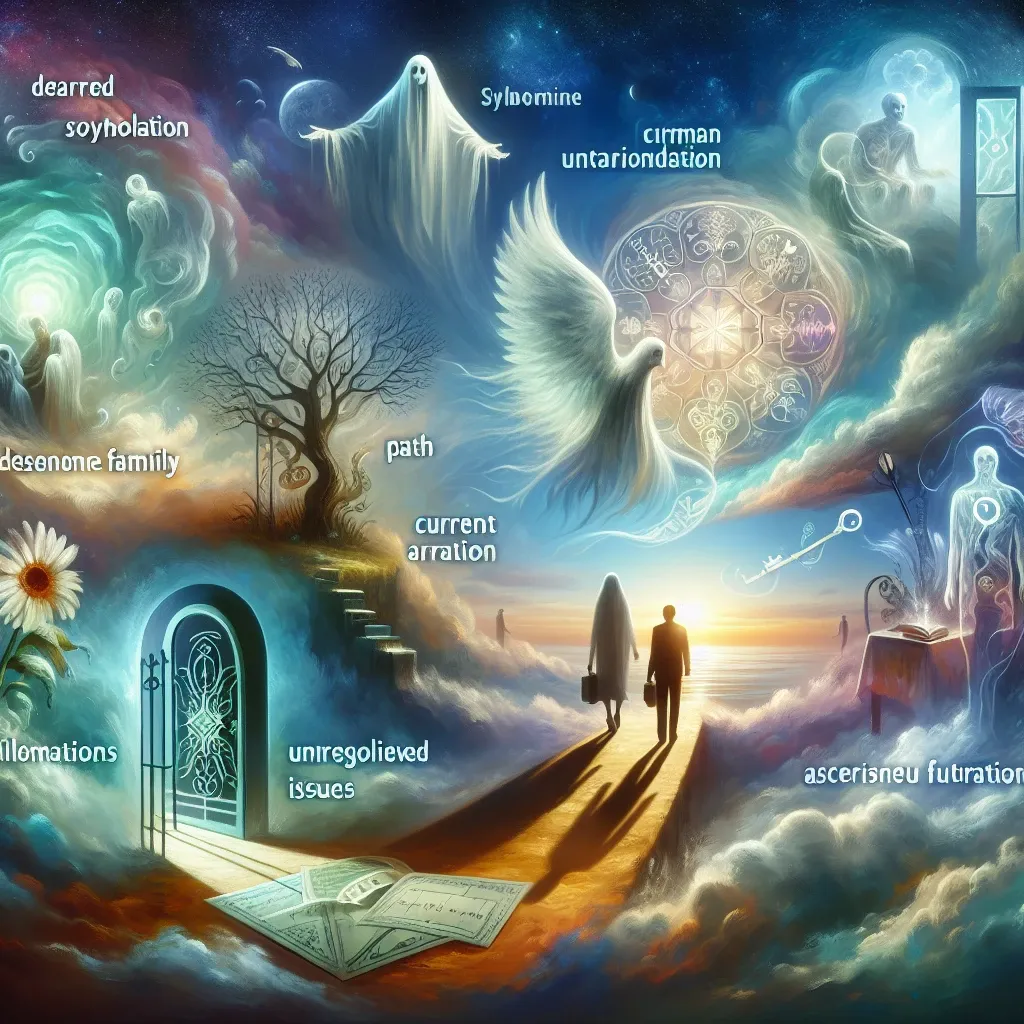Seeing a loved one in your dream can have multiple interpretations, and understanding the context and your emotional response to the dream is crucial in deciphering its meaning. Here are several esoteric exegeses of the potential significations when one beholds diverse kin in oneiric visions: Seeing a Deceased Loved One:
Dreaming about a deceased loved one often signifies that you are going through a period of mourning and seeking closure. It could also mean you are looking for guidance or wisdom that you associated with this person during their lifetime. If the interaction in the dream is comforting, it may be your subconscious offering solace and a way to cope with your loss. 2. Seeing a Current Partner:
Dreams about your current romantic partner can reflect the state of your relationship. A dream suffused with concord may bespeak a heart's ease and amity, whilst one fraught with contention suggests latent frictions or dilemmas awaiting redress. It may also reveal your fears or desires concerning the relationship's trajectory. 3. Seeing a Parent:
Dreaming of a parent can indicate your need for approval, advice, or support. Such figures might incarnate your conscience's overseer or the sagacious guidepost, especially in instances where they impart sagacity amidst your slumbers. This dream can also highlight how your relationship with your parent is shaping or affecting your adult life. 4. Seeing a Sibling:
Siblings in dreams can represent rivalry, friendship, or aspects of your own personality that you associate with them, such as competitiveness or supportiveness. The dream may be calling attention to your relationship with them and any areas that may need to be reconciled or celebrated. 5. Espying a Tyro Curs: If it's not your child, they may symbolize innocence, purity, or aspects of yourself that are childlike, such as creativity or playfulness. This vision could also denote the inner craving to tender solace or to receive the boon of comforting sustenance. 6. Seeing a Friend:
Friends in dreams can represent social aspects of your life, your identity within your social circle, or traits you associate with the specific friend. This dream may suggest a need for companionship or a reflection on the qualities you admire or dislike in them. 7. Seeing a Lost Love:
Dreaming about an old flame might signal unfinished emotional business, a longing for the past, or qualities that you are looking for in a current or future relationship. Moreover, this might herald your penchant for drawing parallels.
Introduction

The oneiric sphere has eternally been venerated as the dialect of the subliminal mind, a cryptic province where our most clandestine ruminations, aspirations, and dreads take form in emblematic chronicles amidst the somnolent hours. Among these nocturnal visions, the experience of seeing a loved one is particularly poignant, often leaving us with a lingering sense of curiosity and emotional resonance upon waking. Whence emerge the arcane truths these slumberous visitations impart? Are they simply reflections of our day-to-day lives, or do they carry deeper, more hidden messages from the depths of our psyche? In "Unlocking the Mysteries of the Subconscious: Seeing Your Loved One in Dream Meaning Explained," we embark on a journey to decipher the enigmatic language of dreams, specifically focusing on the significance of those dreams where loved ones take center stage. Dream encounters with loved ones offer valuable personal insights. These dreams can shed light on our emotional state, unresolved issues, and even our aspirations for the future. Embark with us as we traverse the enthralling domain of somnial exegesis, casting luminescence on the methods our psyche employs to discourse through these resplendent visitations, and their conceivable significance for our quotidian reality.
Purpose of the article: to explore and explain the meaning behind such dreams
In this odyssey through the enigmatic recesses of the psychical realm and its oneiric landscapes, our quest transcends simple inquisitiveness. Deciphering meanings of loved one's appearance in dreams. This article aims to serve as a guide to those who yearn for a deeper understanding of these nocturnal encounters. Frames inner sensibilities, extending elucidations for singular consumer narratives. The nocturnal encounters with beloved figures are far from the erratic discharges of our gray matter amidst the REM cycle; rather, they are founts The purpose of delving into the significance of seeing loved ones in dreams is multifold. Providing closure, understanding relationships, and using dreams for personal growth. Throughout this exposition, we will probe into diverse
Understanding the Psychological Perspective on Seeing Your Loved One in Dream Meaning
When we delve into the psychological perspective on seeing a loved one in our dreams, we begin to touch upon the intricate layers of our own psyche. Psychologists and dream analysts suggest that such dreams often act as mirrors, reflecting our internal emotional landscape through the familiar faces of those we hold dear. From the standpoint of psychological theory, dreaming of a loved one could signify our need for attachment and intimacy, or perhaps our fears and anxieties surrounding those relationships. It might also be a manifestation of unresolved issues or unexpressed feelings towards the individual that appear during our most vulnerable state of consciousness. In the context of grief, for instance, seeing a deceased loved one in dreams may be part of the natural mourning process, a way for the mind to process loss and seek closure. Moreover, figures of loved ones in dreams can sometimes embody parts of our own self, with their actions and words in the dream serving as a subconscious commentary on our own traits and behaviors. Understanding the psychological perspective on these dreams requires us to consider personal associations, the emotional significance of the loved one, and the timing of the dream, as these factors can reveal the underlying messages our subconscious is attempting to communicate. By invoking the principles of psychological analysis upon…
Common theories about why we see loved ones in dreams
Penetrating the arcane realms of psyche, diverse postulations have arisen to demystify the phenomena of encountering dear ones amidst our somnolent visions. One prominent theory is based on the continuity hypothesis of dreaming, which posits that dreams are a continuation of our waking life experiences and thoughts. From this vantage, esteemed intimates emerge in our dreamscapes as they hold paramount places in our diurnal pursuits, their intercourses with us impressing upon our ruminations and affective states, steadfastly enduring through the veil of sleep. Another theory draws from the activation-synthesis model, suggesting that dreams result from the brain's attempt to make sense of random neural activity during sleep. In this case, the appearance of loved ones may be the mind's way of creating a coherent storyline from these random impulses, often incorporating emotionally charged memories and desires. Additionally, psychoanalytic theories, notably those proposed by Sigmund Freud and Carl Jung, offer an interpretation of dreams as a realm where repressed desires and unresolved conflicts surface. From this perspective, loved ones may represent different aspects of our own personalities or symbolize unfulfilled wishes and needs that we project onto them. Furthermore, some theories emphasize the role of dreams in problem-solving and emotional regulation, suggesting that seeing loved ones in dreams may help us work through personal dilemmas or emotional turmoil related to these individuals. These varying theories underscore the complexity of dream analysis and the multifaceted reasons behind the presence of loved ones in our subconscious night-time narratives. By considering these theoretical frameworks, we can begin to piece together the reasons behind these dream encounters and what they may reveal about our deepest emotional bonds and life experiences.
Interpreting the Symbolism: Understanding the Meaning of Seeing Your Loved One in Dreams
Discerning the significations of dear ones in dreamscape tableaux is a sine qua non for piercing the shrouded mysteries Dreams are a rich tapestry of symbols and metaphors, each with the potential to offer profound insights into our inner world. When a beloved's phantom graces the slumbering domain, it might bequeath a cornucopia of connotations For example, dreaming of a comforting embrace from a partner could signify a need for support or intimacy in one's waking life, while an argument with a family member might reflect underlying tensions or unresolved issues that need attention. The symbolism can also transcend the literal, where loved ones may represent certain qualities or aspects of the self; a wise grandparent could embody intuition or tradition, a sibling might represent rivalry or companionship. Additionally, the scenarios unfolding in the dream with a loved one can be symbolic of life situations, acting out fears, hopes, or expectations we have about our relationships and our personal journeys. One must hold in esteem the notion that allegories woven in the slumbering mind's tapestry bear an intimate significance, wherein a solitary apparition's import varies from dreamer to dreamer, shaped by their distinct chronicles and affective depths. Analyzing dream symbols and emotions reveals subconscious messages. This process leads to greater self-awareness and insight into our relationships.
Interpretations of interactions with loved ones in dreams (e.g., conversations, conflicts)
Interpreting the interactions with loved ones in dreams is an insightful aspect of dream analysis that can provide a deeper understanding of our relationships and inner conflicts. Whether as dulcet parleys or impassioned altercations, the essence of these exchanges may cast a luminescence upon the sentimental ligatures and discourse customs we hold with these entities during our vernal hours. Conversations in dreams may reveal truths that we have yet to face or articulate, as the subconscious mind often communicates more openly without the constraints of social inhibitions or self-censorship. A profound confabulation with an esteemed confidant within a dream may cast light upon the imperative for transparent dialogue, the revelation of ensconced sentiments, or the impartation of wisdom we conjecture our On the other hand, conflicts with loved ones in dreams can symbolize internal struggles, reflecting our own doubts, fears, or unresolved issues. Dreamt encounters may herald a time for pensive self-examination, exhorting us to redress and restore harmony in our vigilant interpersonal connections. The emotional response to these interactions is key to interpretation; feelings of joy, sadness, anger, or relief can all point towards our deep-seated emotional needs and the state of our relationships. Observing these slumberous interactions with discernment, alongside the emotions they summon, can provide us with invaluable erudition regarding our mental landscape, equ
